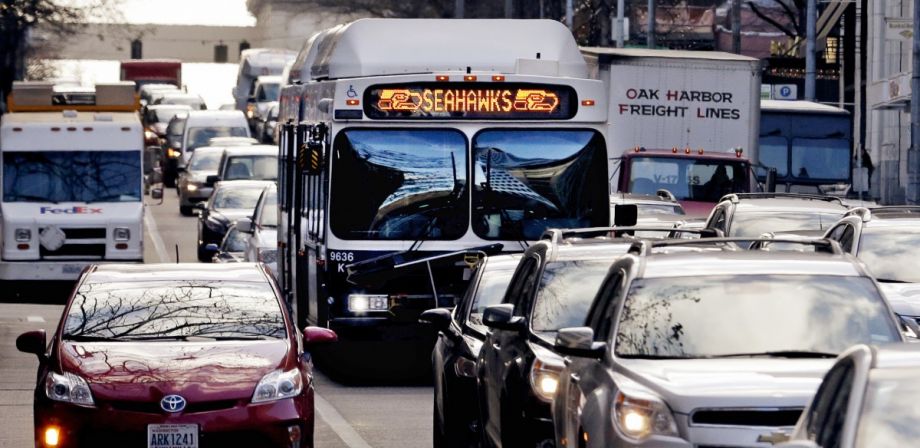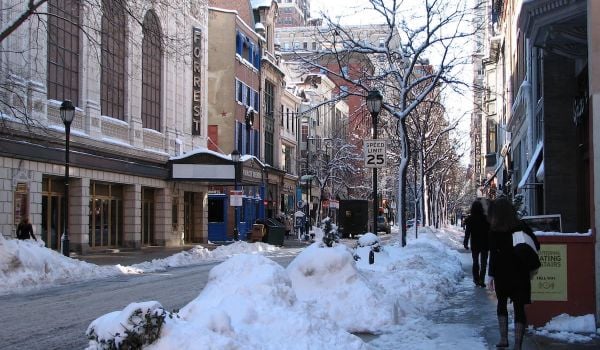Transit Riders Union Trustee Scott Myers chanted into the microphone, “One, two, three, four, we can’t afford the bus no more. Five, six, seven, eight, the bus is always too damn late!”
A third of the 60 or so people in the crowd joined in. The transit advocates, housing and human services providers, labor representatives, and low-income and homeless transit riders weren’t marching a picket line or protesting outside Seattle’s City Hall, but instead celebrating at a brewery in the Capitol Hill neighborhood last Wednesday evening.
The Transit Riders Union is a Seattle organization that advocates for better transit access for low-income and homeless people. This year, in partnership with housing and human services organizations, they successfully lobbied the King County Council for three important changes to King County Metro’s Human Services Bus Ticket Program that will make buses (and trains) more affordable for more people.
The ticket program sold deeply discounted transit passes to human services organizations to give to their clientele who might otherwise be unable to afford transit. Until recently, the passes only worked for buses, were sold at 20 percent the cost of a full-price ticket, and had a $2.55 million subsidy cap. (Essentially the program offered $2.55 million worth of full-priced tickets at the discounted rate.) Because of the cap, many service providers would rarely get enough tickets to last through the year.
“We serve 300 people a day [at day services centers],” Compass Housing Alliance’s Shree Vigil said on Wednesday. “Each year we would request way more tickets than King County would provide and could only give out 36 a day.”
In March, Metro expanded the ticket program to include LINK light-rail day passes — a move that will become increasingly important as light rail continues to expand in the region. In September, the King County Council voted unanimously to raise the subsidy cap to $3.6 million. And in November, the Council voted to reduce the ticket price from 20 percent to 10 percent of full price.
North Helpline food bank’s Nikki Hurley said her organization had to stop offering tickets to clients because it was still too expensive at the 20 percent rate. But with the new price, they plan to once again give out tickets.
Katie Wilson, Transit Riders Union’s general secretary, describes the ticket program as a lifeline. “Being poor and being homeless is a lot of work. It’s a lot of work just to get to the basic things you need to do to survive, let alone the places you need to go to improve your economic situation, or heck, even the things that make life good, like going to visit friends.”
There are other discounted transit pass options. The ORCA Lift card is a cheaper version of the regional transit pass, available for people earning up to double the poverty line. Lift users can either purchase an unlimited monthly pass for $54 or load money onto the e-purse and pay $1.50 for rides instead of the full $2.50 to $2.75 fare.
But Wilson points out that if you’re homeless or living on a meager fixed income, $54 a month is likely untenable. And though people may perhaps have the $1.50 necessary for a ride, you can’t load less than $5 onto an ORCA card, and riders can’t get the discounted rate when paying cash.
“There’s just a big section of the population who just can’t afford that, and they’re people for whom public transportation is most essential for getting around,” Wilson says.
There is a strong link between transportation access and upward economic mobility. A 2015 study by New York University’s Rudin Center for Transportation found that “limited transit access is linked to higher unemployment.” The focus of the study was whether or not a neighborhood had transit, but if transit is too expensive to ride, it is also inaccessible.
In November, King County Executive Dow Constantine made a commitment to investigate other ways to help homeless and low-income transit riders. He released a statement directing, “Metro to engage other transit agencies, the state, other local jurisdictions, human services agencies and other potential partners in a discussion of transit’s role in contributing to the social safety net for the lowest income residents, and how to provide assistance while still being able to meet the growing demand for transit service throughout King County and the region.”
Cities around the U.S. are experimenting with different approaches to facilitating low- and no-income transit ridership. San Francisco’s MUNI offers a half-priced pass for very-low-income residents. Metro Transit in St. Paul and Minneapolis has a program similar to King County Metro’s that sells discounted tickets for service providers to distribute.
In New York City, the Community Services Society and the Riders Alliance are lobbying for the Metropolitan Transportation Authority (MTA) to create a half-priced Metro card available for people on the poverty line. The program is estimated to cost $200 million and serve 800,000 residents. Mayor Bill de Blasio said that while he likes the idea, it would be on the state-funded MTA to come up with the money for it.
“An additional $200 million is going to be very hard to find in the city budget … . A noble idea. A commendable idea. We’re going to look at it in the budget process. But it’s a tough one,” he said in a recent interview.
Wilson says that the most promising program is coming from Calgary, which is implementing a sliding scale monthly transit pass in January. The pass will cost as little as $5.15 per month for unlimited rides. Calgary City Councilor Brian Pincott told Metro News the program was specifically about helping, “the most vulnerable in our community have the opportunity to access services, to access education, jobs. Public Transit was a barrier to all of those things.”
Transit Riders Union is advocating Metro and Sound Transit adopt a similar sliding scale for the ORCA smartcard, but Wilson says it probably couldn’t be implemented until the more advanced second-generation smartcard system gets rolled out in several years.
But in the meantime, they have plenty of ideas for increasing transit access for homeless and low-income residents including: extending the human services ticket program to include Seattle’s streetcars, allowing service providers to buy unlimited monthly passes at 10 percent the cost to distribute to clients, removing the $5 minimum load limit on ORCA cards and more.

Josh Cohen is Crosscut’s city reporter covering Seattle government, politics and the issues that shape life in the city.
Follow Josh .(JavaScript must be enabled to view this email address)
















